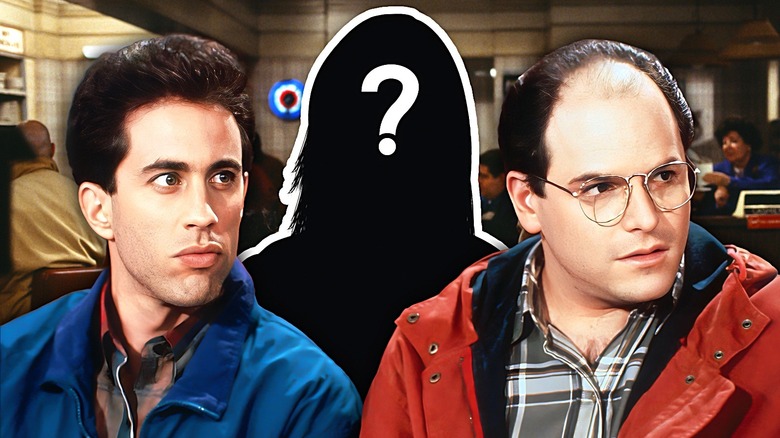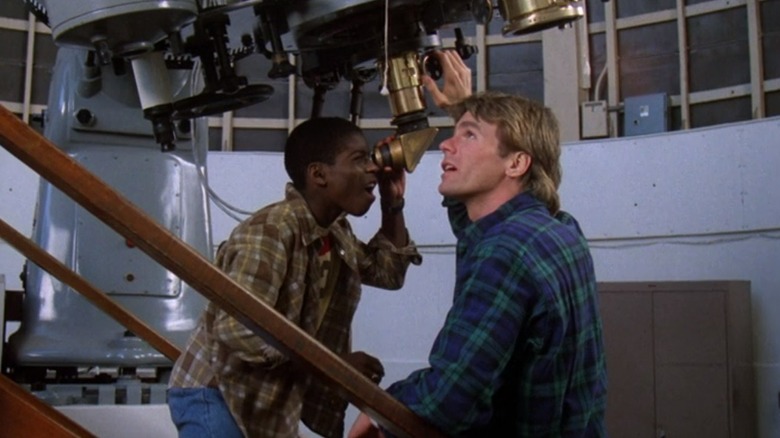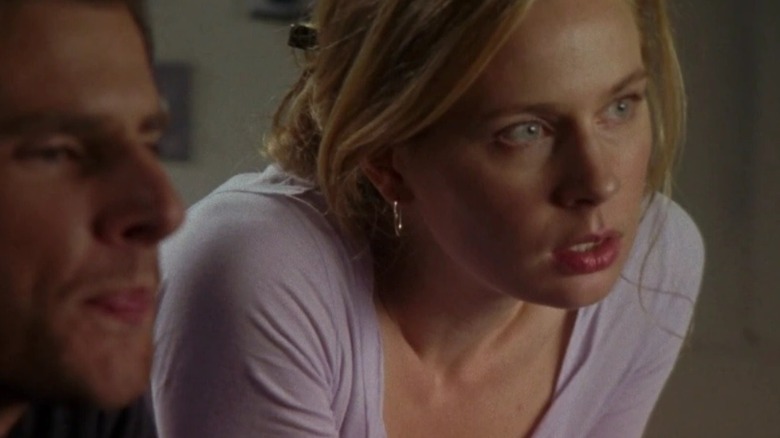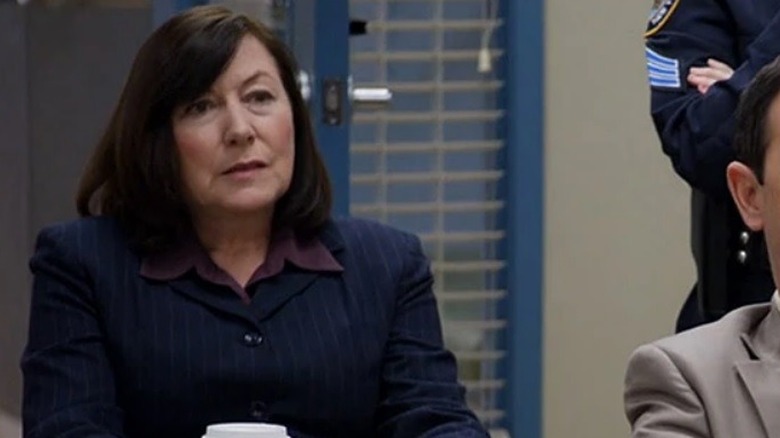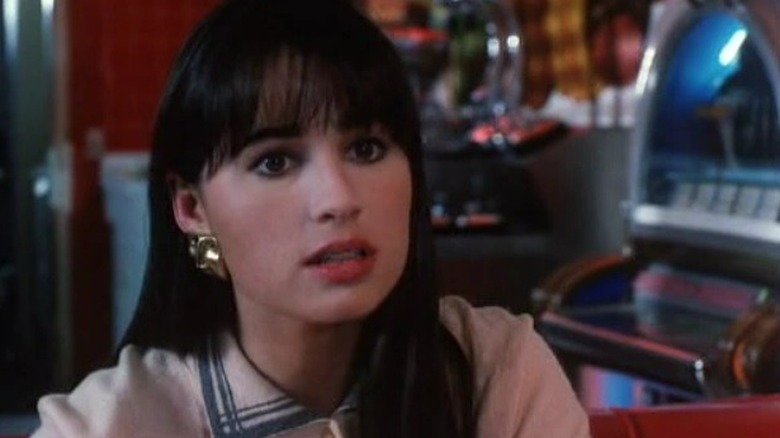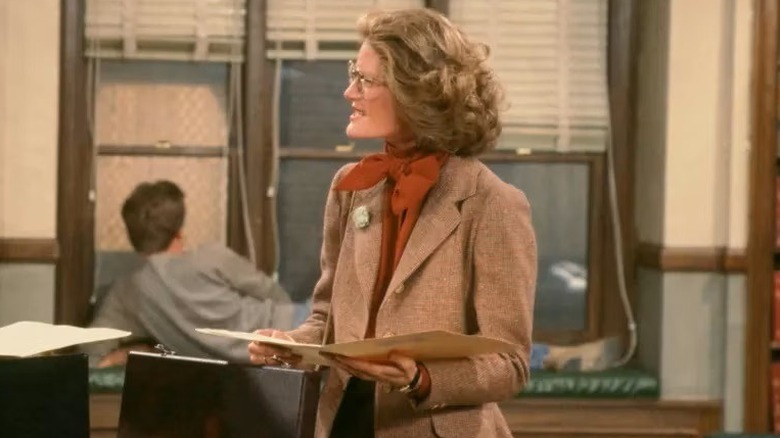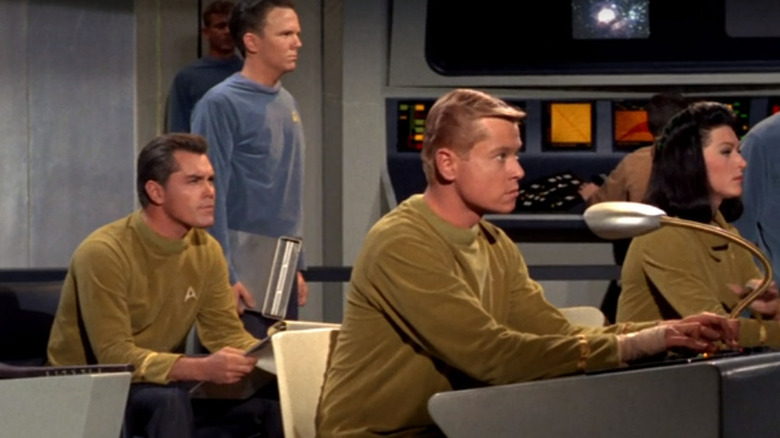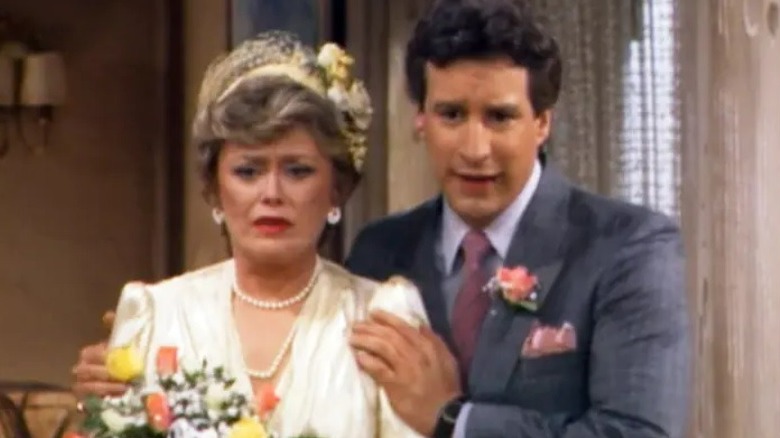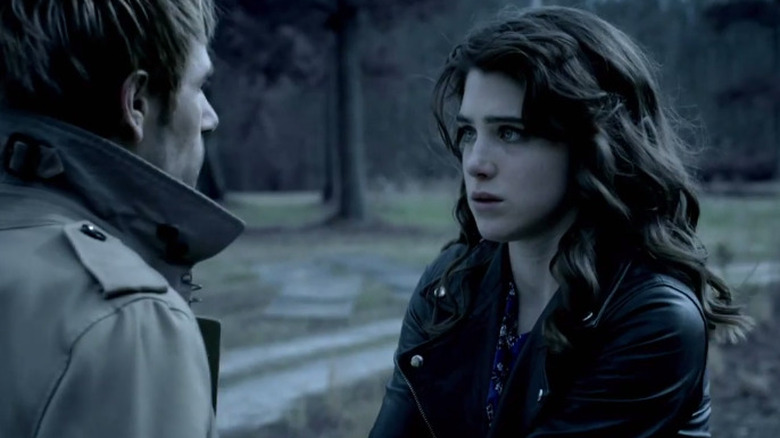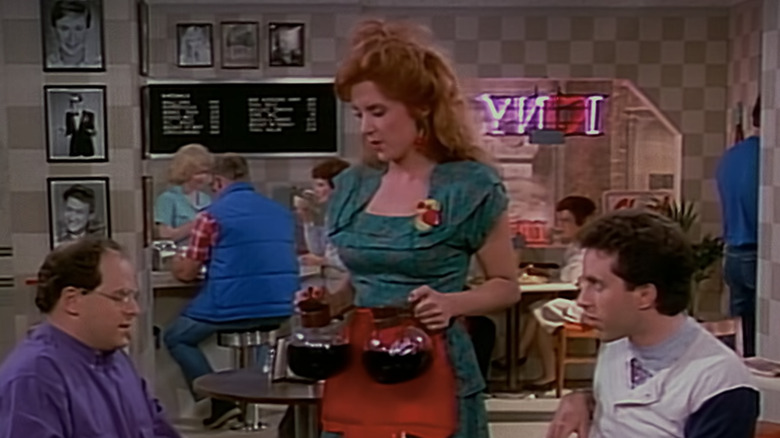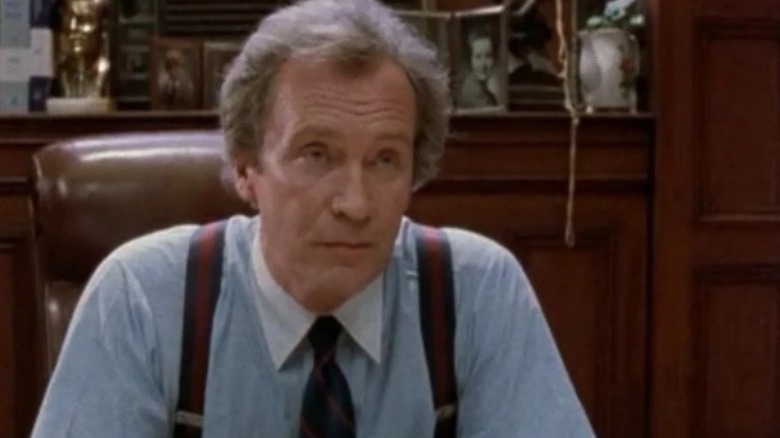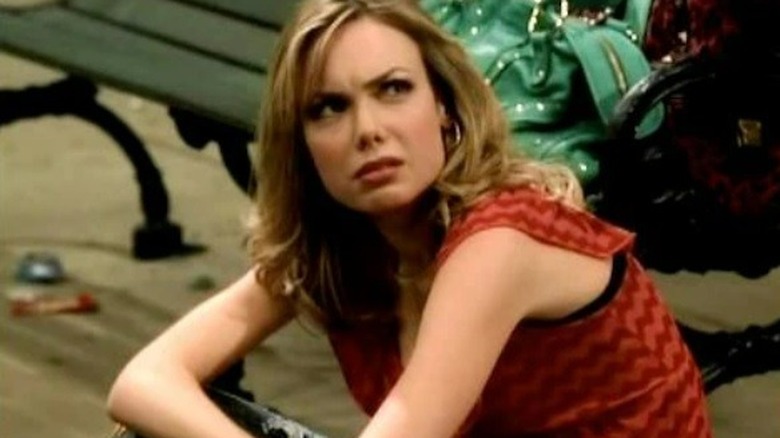TV Characters That Were Cut After The Pilot
So why, exactly, is the first episode of a television show called a "pilot?" Despite a commonly-held theory that it's an aviation-adjacent term — going along with TV shows being on the "air" — it's actually related to the scientific process of using a pilot study to test the viability of further research. So the pilot of a TV show is a way for a network to gauge the future success of a potential series. As such, pilots are often used to work out a new show's kinks.
Going through the effort of fully producing an episode allows everyone to see what works and what doesn't, and changes of varying degrees are made before the series continues. Sometimes viewers are part of this process, where a show will air its test pilot far in advance of the full series' plan start date so that audience feedback can be implemented before the show returns later to begin its actual run. In other instances, pilots are only for internal use, and the first episode that makes it to air is actually the refined draft of that episode.
In both aired and unaired pilots, there have even been examples where characters that were originally intended to play a major role in the series don't work out and are deleted from the show entirely. Sometimes their departure is explained in-universe, while other times the show simply pretends they never even existed.
Reggie - MacGyver (original)
The protagonist of the classic 1980s action series "MacGyver" is best known for his ingenuity, able to miraculously fashion the very device he needs to solve or escape from the situation at hand out of whatever random items happen to be lying around. Sometimes this involved simply combining two things to cause an explosion. But the show often got much more elaborate than that — like the time MacGyver (Richard Dean Anderson) took a car's seat cushion, muffler, gear shift knob, and cigarette lighter, and transformed those components into a working bazooka.
The only other two main characters through much of the original show's run were his boss Pete Thornton (Dana Elcar) and his buddy Jack Dalton (Bruce McGill). But MacGyver also originally had a young pal named Reggie (Shavar Ross) who was introduced in the pilot and identified himself as MacGyver's "little brother." As Ross explained on the "MacGyver" podcast "Phoenix Project," he was originally meant to be a major character on the show as MacGyver's child sidekick, and had accompanied Anderson on the original press tour to promote the series.
But after the pilot aired, Ross received a phone call from "MacGyver" executive producer Henry Winkler informing him that the show was going in a slightly different direction — a Reggie-less direction, to be exact. From episode two on, Reggie was gone with zero explanation. He didn't return for the embattled 2016 reboot, either.
Lucinda Barry - Psych
Characters that disappear after pilots don't always just magically vanish as if to have never existed. There are times when a show's creative team goes through the effort of having the character's departure written into the show. A fascinating example of that came by way of the police procedural dramedy "Psych," which introduced a love interest for one of the show's main characters in the pilot only to immediately take her away — and have that be a major plot point.
In the pilot episode, Detective "Lassie" Lassiter (Timothy Omundson) has a romantic entanglement with his partner, Lucinda Barry (Anne Dudek). He's technically still married at the time, though he and his wife are separated. "Psych" creator Steve Franks later told Entertainment Weekly that the test audiences for the pilot had missed the detail about the separation, and thought that Lassiter was straight up cheating on his wife with Lucinda — which gave the audience a negative first impression of him. Not wanting the audience and Lassiter to get off on the wrong foot, the show explained that Lucinda was transferred due to the exposure of her protocol-breaking relationship with Lassiter.
Instead, the second episode introduced Juliet O'Hara (Maggie Lawson) to be Lassiter's new partner, allowing something of a fresh start between Lassiter and the audience. While Lucinda was never seen again, a Season 7 Easter egg implies that she passed away at some point via a shooting range tournament named in her memory.
Detective Daniels - Brooklyn Nine-Nine
From the very beginning, "Brooklyn Nine-Nine" stood out as an incredible ensemble piece. The show was absolutely chock full of characters, and not a single one was wasted or felt like they didn't have their place within the overall group. That being said, there were a few smaller groups that had their own thing going on — such as detectives Norm Scully (Joel McKinnon Miller) and Michael Hitchcock (Dirk Blocker), a hilarious duo of inept law enforcement officers who had most of their best moments together.
However, the first episode of "Brooklyn Nine-Nine" seemed to be positioning that duo as a trio. In addition to Scully and Hitchcock, there was also a woman named Daniels who was lumped in with them as they were initially introduced to Captain Holt. But while both Scully and Hitchcock appeared on the show for 142 of its 153 episodes, Daniels was never seen, heard of, or mentioned again after the pilot. She never got a first name, and even the identity of the actor who played her remains a mystery, which is by far the strangest facet of the Daniels disappearance.
Iris West - The Flash (1990)
The first live-action version of the iconic DC Comics speedster The Flash to make it to the screen was the 1990 TV series of the same name. It only lasted for a single 22-episode season, but it deserves its due for helping to pave the way for the many DC TV shows that followed. The actor who played Flash/Barry Allen, John Wesley Shipp, later played the father of the Arrowverse's Barry Allen — and, eventually, directly reprised the role of Barry Allen himself from the universe of the 1990 TV show in the Arrowverse's various multiverse events.
As for the original show, Barry was partnered with his most well-known and longest-lasting love interest from the comics — Iris West (Paula Marshall) — in the pilot episode. But Iris was gone after that, making way for Tina McGee (Amanda Pays) to take over as Barry's female co-lead for the remainder of the series. At the time, Tina was a fairly new character in the "Flash" comics, and was initially the love interest of the Wally West version of the character.
As for why Iris had to go, Shipp said he didn't know for certain but could only theorize, telling Comic Book Bin, "I think she appeared much younger than me. Maybe they felt that the chemistry wasn't right." Iris West was played by actor Candice Patton when she made her return in the Arrowverse.
Sheila Gardener - Night Court (original)
It's easy to roll one's eyes whenever another reboot or revival of a classic TV series is announced, as they tend to miss far more often than they hit. But the 2023 return of "Night Court" proved to be an example of a sitcom comeback done right, met with both critical acclaim as well as ratings that quickly earned it a second season. Much of that success is thanks to the extremely strong foundation left over from the still-beloved 1980s original.
Though the list of actors who appeared in the first run of "Night Court" who have since passed away is sadly long, the characters they played have all earned their spot among the pantheon of iconic sitcom greats. But the ensemble wasn't fully formed right from the start. For instance, Christine Sullivan (Markie Post) didn't come aboard until Season 2. In her stead in the first season was Lana Wagner (Karen Austin), the main female lead for all of Season 1 and only Season 1.
But the pilot episode saw another female character who didn't even make it to the second episode — public defender Sheila Gardner, played by actor Gail Strickland. Strickland herself didn't disappear, though, as the actor had a steady stream of gigs on both the small and big screens throughout the '80s and '90s.
Pretty much everybody - Star Trek: The Original Series
This is one of the more unusual and more drastic examples of hemorrhaging characters from a pilot episode. But unlike the rest of the characters on this list, the actual original "Star Trek" crew did eventually get to come back after their post-pilot deletion — even though it took an astounding 56 years for that comeback to be fully realized. The show's original pilot, known as "The Cage," was rejected by NBC, who then ordered another one.
During the retooling process between those two episodes, most of the Enterprise crew from the first — Capt. Pike (Jeffrey Hunter), Number One (Majel Barrett), and Dr. Boyce (John Hoyt) — were nixed entirely. Only Mr. Spock (Leonard Nimoy) made the cut when the new and much more familiar crew of Kirk, Bones, Sulu, Uhura, and Scotty was formed for the second go-round. That's the one that NBC preferred, and the first batch was essentially fired. Though they made small appearances in various "Star Trek" media over the years, it wasn't until 2022's "Star Trek: Strange New Worlds" that Pike and his crew finally made their proper return.
"The Cage" has been listed as the first episode of Season 1 of the original series in various box sets and streaming services over the years, and is also technically the pilot for "Strange New Worlds," effectively making it an entry point for two different TV shows that premiered over 50 years apart.
Coco - The Golden Girls
It's hard to imagine "The Golden Girls" beyond the foursome we all know and love. Not only were Dorothy, Rose, Blanche, and Sophia all flawless characters who each fit in the group like a glove, but their actors — Bea Arthur, Betty White, Rue McClanahan, and Estelle Getty — had incredible chemistry together. Adding another character to that mix feels a little like trying to balance a car on five wheels.
Except, the show did have five leads when it began. The original pilot featured not only those three Miami housemates — plus Sophia, who eventually moved in too — but a live-in chef and housekeeper named Coco (Charles Levin). "The Golden Girls" was already known for being more progressive than most sitcom fare of the time, and it would've been even more so had the openly gay former drag performer Coco stayed on as a series regular. An uncloseted queer character playing a major role on a network television show was still a fairly new idea in 1985, and was many years away from seeing any sort of widespread prevalence.
Unfortunately, Coco didn't end up being the LGBTQ+ trailblazer he should've been. When the pilot ran a few minutes too long, the bulk of Coco's scenes comprised the pare down. All but absent from the final cut of the pilot, there wasn't much to justify keeping him on board when the show got its full season order from the network.
Liv Aberdine - Constantine
Superhero TV shows were doing very well in the mid-2010s — so much so that even NBC got in on the action with its own take on the DC comics antihero "Constantine." With connections to the CW's Arrowverse, actor Matt Ryan played the role of occult detective and demon hunter John Constantine, drawing elements from both the original comics he appeared in as well as the 2005 Keanu Reeves film adaptation. Playing a major role in the original pilot episode is the character Liv Aberdine (Lucy Griffiths), who was very clearly positioned to be a major part of the series going forward.
That is, until she wasn't. Fans were confused when it was announced that neither Liv nor Griffiths would be returning to the show after that first episode. During a press tour for the show, showrunner Daniel Cerone and executive producer David S. Goyer explained that the writers' room realized they had erred in building the show around Liv. They realized that Constantine needed a better foil — and decided that someone with psychic powers would have a much more interesting dynamic to play off Constantine being a manipulative con artist.
So Liv was out, and in her place from the second episode was Mary "Zed" Martin (Angélica Celaya), who — unlike Liv — was an existing comic character. The ending of the pilot was then tweaked to make it clear that Liv and Constantine were parting ways, explaining why she's never seen again.
Claire - Seinfeld
There is a lot about the pilot episode of "Seinfeld" — back when the show was still known as "The Seinfeld Chronicles" — that was different from the rest of the series. Jerry's apartment looked different, his dad was played by a different actor, the characters' preferred eatery was Pete's Luncheonette instead of Monk's Café, Kramer was named "Kessler," and perhaps most jarring of all, Elaine was nowhere to be found.
Instead, taking on the de facto role of female lead in that first episode was Claire (Lee Garlington), a waitress at Pete's Luncheonette. Though various waitresses came and went on "Seinfeld" over the years, Claire was very much intended to be a series regular. As to why Claire didn't survive the transition from "The Seinfeld Chronicles" to "Seinfeld," everyone seems to have a slightly different recollection of what went down. NBC executive Warren Littlefield said it was because she was a waitress, which relegated her to only ever being a passive member of the group. George Costanza actor Jason Alexander claimed that Garlington got on co-creator Larry David's bad side when she suggested script changes. As for Garlington herself, she simply states that they never picked up her contract, and tends to leave it at that.
Whatever the reason, from the second episode on, Claire the waitress was out — and Elaine Benes (Julia Louis-Dreyfus) was in. And no disrespect to Garlington, but it was the right decision for the show.
Alfred Wentworth - Law & Order
Those who were watching "Law & Order" as it was originally airing were likely pretty confused when they got to the sixth episode — "Everybody's Favorite Bagman." Suddenly there was a district attorney they had never seen before named Alfred Wentworth (Roy Thinnes) who seemed like a pretty big deal. Yet he hadn't been so much as mentioned previously, and then in the next episode, he was gone again, never to return.
So what's the deal here? Well, "Everybody's Favorite Bagman" was originally filmed as the show's pilot, and actor Roy Thinnes was going to be a series regular as D.A. Wentworth, the show's main district attorney. But scheduling issues caused him to pass on the show full time, so both he and Wentworth were gone, and his role was filled by D.A. Adam Schiff (Steven Hill) instead. It wouldn't have been as big of a deal if that episode had aired first, as it was intended — but when it was episode 6 of Season 1 instead, it was jarring to have a major character appear out of nowhere and then disappear again just as quickly.
Thinnes returned to the "Law & Order" universe multiple times, but always in one-off appearances and as an entirely different character — only ever playing D.A. Wentworth that first time.
Katie - The Big Bang Theory
"The Big Bang Theory" isn't just a show about a bunch of nerdy scientist dudes hanging out — that would've gotten old pretty quickly. Instead, much of it was built around the sexy new neighbor girl who moves across the hall from roommates Leonard (Johnny Galecki) and Sheldon (Jim Parsons), and the way Leonard is instantly smitten with her. The show smartly doesn't waste a bunch of time in getting Penny (Kaley Cuoco) to be friendly and hang out with the guys, and has her almost immediately diving full-on into their social circle.
In the original unaired pilot, it didn't go quite so smoothly. Instead, the role that Penny played in the first episode was originally a girl named Katie (Amanda Walsh). "Big Bang Theory" co-creators Chuck Lorre and Bill Prady admit that Katie didn't go over well with the test audience — instead of defaulting to being sweet to the boys, she was much meaner and more antagonistic toward them. She would likely have softened with time to become more like Penny, but the audience might not have stuck it out and waited for that to happen. So everyone went back to the drawing board, Katie was out, Penny was in, and they took another crack at it — the results of which speak for themselves.
